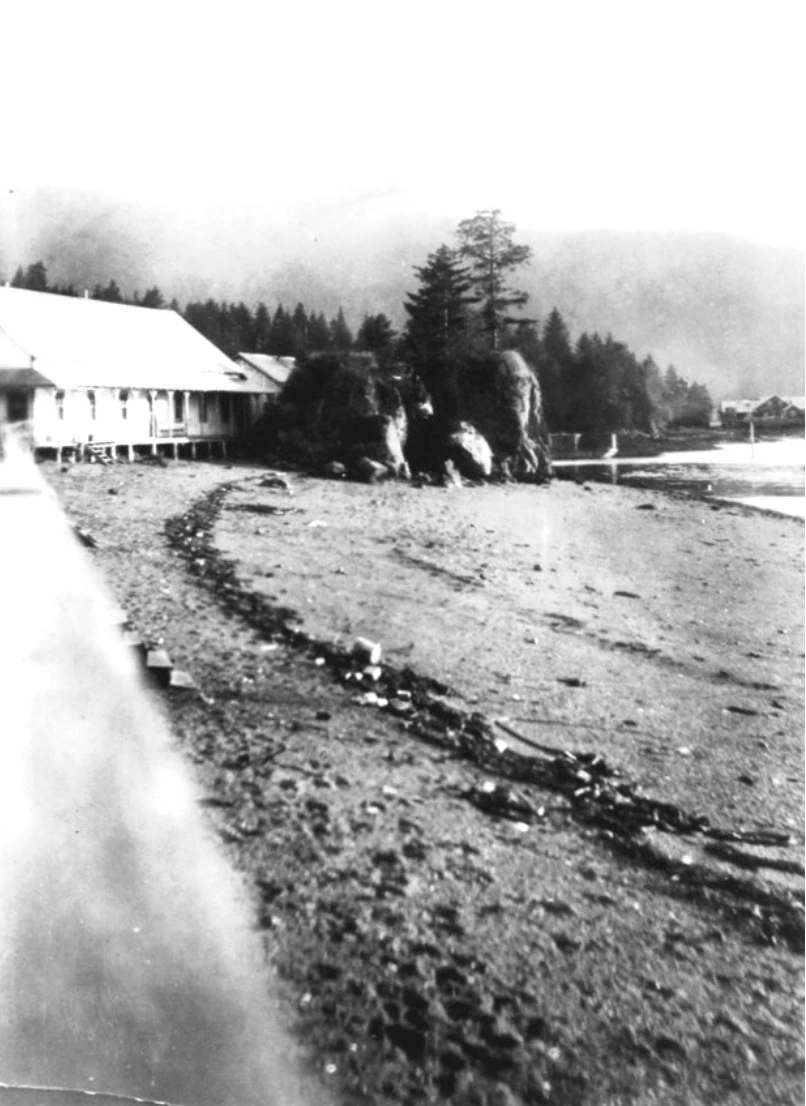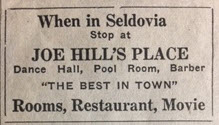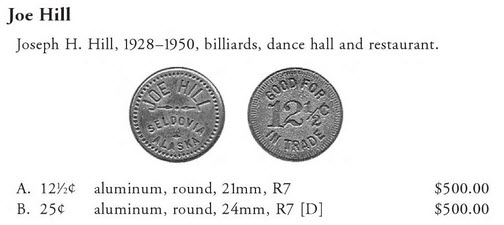Joe Hill’s Dance Hall
Joe Hill came to Seldovia in the 1920s and it wasn’t long after that that he established Joe Hill’s Hall. When Prohibition ended he could legally include a bar and eventually even showed movies there. In 1940 the saloon burned to the ground in an impressive fire visible even from Homer, and later Joe rebuilt the Polar Bar and operated it until 1948 when he was forced to cede the property to the new owner, Frank Raby.

Here is an ad from Seward newspaper in 1927.

Tokens were common forms of payment in Seldovia. This one for Joe Hill’s Hall sells for more than $500 today.

From Elsa Pederson’s A Larger History of the Kenai Peninsula
“Joe Hill’s dance hall was the social center of town. Built on the rocky point at the mouth of Seldovia Slough, it contained a bar and a barber shop and the dance hall. Joe cut hair, tended bar and kept order with deft efficiency. The only black man ever to make his home in Seldovia, he was known as the “whitest man” in town.
He backed many a fisherman over a poor season, financed boats, helped many hard pressed families. It was said he never left his place of business, where he also lived, except to attend a funeral.”
“The dance hall burned one night, patrons erupting through windows into the chilly waters of Seldovia Bay.”
From Susan Springer’s book: Seldovia Alaska: An Historical Portrait of Life in Herring Bay
Perhaps the best-known, most well-liked business on the entire Waterfront was Joe Hill’s Hall. “Joe Hill, a black man, was probably the finest man in town, and was a highly respected by everyone” wrote Jim Busey. In testimony to his pure heart and character, Joe carried the distinction of being known as “the whitest man in all Seldovia.” When Jim and his parents came to Seldovia in 1928, Joe ran a pool hall and barber shop. After fire destroyed the business, Joe relocated to a larger building at the mouth of the Seldovia Slough. Joe’s second location “included the same facilities as previously, plus a large dance hall that was used for a city auditorium, dance hall, school graduation, and other important public events. Joe was especially liked because of his high standards of personal conduct. Contrary to the more usual practice in Seldovia, he did not drink, and he was well informed, an interesting and literate person, who played an important role among numbers of admiring people, you and old.” (Busey). From the Russian Christmas masquerade dances to basked socials benefiting one cause or another to plays put on and performed by the Seldovia Women’s Club, Joe Hill’s Hall played host to most social events in town.
Perhaps a more important role played by Joe was a quiet one: that of local philanthropist. Stories still circulate about how Joe carried more than one fishing family through a hard winter, or financed a boat for others. Seldovian Albert Wilson recalls being taken care of by Joe Hill. Circumstances prevented his staying at home for a period as a child, and so he went to live with Joe, who fixed him breakfast each morning and bustled him off to school.
After prohibition, Joe added a tavern to his multifaceted hall, but it was said he permitted no misconduct there. The tavern and dance hall were separate from one another, so that youngsters could enjoy a dance while some of their elders whiled away the evening in the tavern. The tavern business created employment for a number of boys. In the winter, Joe provided big toothed saws with which ice could be cut from Susan Lake the boys hauled the cut ice to Joe’s on a sled and stacked it and then covered it with sawdust. Joe paid the $5.00 a ton, and used ice to cool his beer through the warmer months. A typical winter’s store of ice was as much as 23 tons.
Joe was known for not picking up things off his floor. Instead, like most buildings along the boardwalk, his had a trap door through which debris was swept onto the bench. Included in Joe’s debris were half gallon and gallon wine jugs. Children picked these up of the beach and sold them back to Joe for a quarter apiece. This was a smart move on Joe’s part for the youngsters generally turned right around and handed back the money as entrance to the latest moving picture show. The beach below Joe’s was also a favorite place for children to scavenge for money – change mostly, but on one rare occasion a greenback. He neglected to sort this out from the end-of-an-evening rubbish on the floor, so out onto the beach it was swept.
Joe Hill showed movies twice a week, with photograph or live piano music preceding the picture. He ran the whole operation himself, and took time to lecture young people who came in for a haircut. In fact it is said that with Joe trying to tend bar and oversee the pool hall while running the barbershop, a haircut could take the better part of a leisurely afternoon.
On December 3, 1940 Joe Hill faced a second fire and his famous dancehall/pool hall/movie theatre/tavern/barbershop burned to the ground. Joe later rebuilt and operated the Polar Bar until retiring to Philadelphia. There he spent the last years of his life involved in the Civil Rights movement.
Several years ago, a friend of mine was mucking about in the slough below where Joe Hills used to stand. To his delight he found a china barber pole, about 6’ high and still bearing its red and white striping. It was hollow, and with a good sized slot in the top. We realized he had found the receptacle for Joe’s used razor blades! An insignificant treasure to be sure, but still somehow proof for us 1990s folk that this great man did indeed exist.”